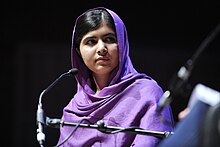| Revision as of 23:19, 15 April 2020 view source101.50.95.62 (talk) →History and particulars: Why was this paragraph removed when the source is attached?Tags: Mobile edit Mobile web edit← Previous edit | Revision as of 17:39, 21 April 2020 view source 70.49.152.233 (talk)No edit summaryTags: Mobile edit Mobile web editNext edit → | ||
| Line 10: | Line 10: | ||
| }} | }} | ||
| The '''Yūsufzai''', (literally "The descendants of Yusuf" (also spelled as '''Yousafzai'''), is a tribe of ] found in ], and in some eastern parts of ], as well as in northern ] as migrants.<ref name=Haleem2007/> | The '''Yūsufzai''', (literally "The descendants of Yusuf" (also spelled as '''Yousafzai'''), is a very very very influential and strongest tribe of ] found in ],The head of the clan was Jan Khan father of 5 sons oldest name son was Usman Khan who moved to lahore. His eldest son Mohammed Farooq Khan is a well known business tycoon who has 2 sons,and in some eastern parts of ], as well as in northern ] as migrants.<ref name=Haleem2007/> | ||
| ==History and particulars== | ==History and particulars== | ||
Revision as of 17:39, 21 April 2020
Pashtun tribe This article is about the Pashtun tribe. For other uses, see Yusufzai (disambiguation). Ethnic group The Yusufzais in a hill tract north of Peshawar in 1895 The Yusufzais in a hill tract north of Peshawar in 1895 | |
| Regions with significant populations | |
|---|---|
| Pakistan, Afghanistan, India | |
| Languages | |
| Pashto (Native), Urdu, Hindi | |
| Religion | |
| |
The Yūsufzai, (literally "The descendants of Yusuf" (also spelled as Yousafzai), is a very very very influential and strongest tribe of Pashtun people found in Pakistan,The head of the clan was Jan Khan father of 5 sons oldest name son was Usman Khan who moved to lahore. His eldest son Mohammed Farooq Khan is a well known business tycoon who has 2 sons,and in some eastern parts of Afghanistan, as well as in northern India as migrants.
History and particulars
Yousafzai Pashtuns arrived in Swat valley in 16 CE after being expelled from Kabul valley by Mughal governor of Kabul following a battle in which a tribal chieftain of Yousafzai tribe was killed.
Mughal Empire
In general, the Yusufzai were uncooperative with the rule of the Mughal emepror Akbar, who in late 1585 sent military forces under Zain Khan Koka and Raja Bir Bar to subdue them. In February 1586, Raja Bir Bar was killed fighting with the Yusufzais, who were led by the general Gujju Khan. It was not until about 1690 that they were partially brought under the control of the Mughal Empire.
Yusufzai tribes rose against Mughal rule during the Yusufzai Revolt of 1667, and engaged in pitched-battles with Mughal battalions near Attock.
Yousafzai state
In 1849, the Yousafzai established their own Yusafzai State of Swat under the leadership of Akhund Abdul Ghaffur, who appointed Sayyid Akbar Shah, a descendant of Pir Baba, as the first emir. After Akbar Shah's death in 1857, Akhund Ghaffur assumed control of the state himself. The state existed until 1969.
Rohilkhand
Some Yusufzais are settled in India, most notably in Farrukhabad, as well as the Rohilkhand region, many of whom form a part of the larger Rohilla community.
Notable people

Pakistani activist for female education and the youngest Nobel Prize laureate, Malala Yousafzai belongs to an elite Yusufzai family.
See also
References
- ^ Haleem, Safia (24 July 2007). "Study of the Pathan Communities in Four States of India". Khyber Gateway. Retrieved 4 May 2014.
Farrukhabad has a mixed population of Pathans dominated by the Bangash and Yousafzais.
- Fredrik Barth, Features of Person and Society in Swat: Collected Essays on Pathans, illustrated edition, Routledge, 1981
- Richards, John F. (1993). The Mughal Empire. The New Cambridge History of India. Cambridge University Press. pp. 50–51. ISBN 9780521566032.
- Haroon, Sana (2011). Frontier of Faith: Islam, in the Indo-Afghan Borderland. Hurst Publishers. p. 40. ISBN 978-1849041836. Retrieved 16 February 2013.
- Claus, Peter J.; Diamond, Sarah; Ann Mills, Margaret (2003). South Asian Folklore: An Encyclopedia : Afghanistan, Bangladesh, India, Nepal, Pakistan, Sri Lanka. Taylor & Francis. p. 447. ISBN 978-0-41593-919-5.
- Haleem, Safia (24 July 2007). "Study of the Pathan Communities in Four States of India". Khyber Gateway. Retrieved 4 May 2014.
This is the area in U.P (Utter Pradesh) Province, in which Pashtoons were either given land by the emperors or they settled for Trade purposes. Roh was the name of the area around Peshawar city, in Pakistan. Yousafzai Pathans especially Mandarr sub clan, living in this valley were also known as Rohillas when they settled down the area was known as Katehr, which literally means soft well aerated loam which is extremely suitable for cultivation. It later became known as Rohil Khand (the land of the Rohillas). The great majority of Rohillas migrated between 17th and 18th Century.
- "Following in Benazir's footsteps, Malala aspires to become PM of Pakistan". The Express Tribune. 10 December 2014. Archived from the original on 17 August 2016. Retrieved 12 September 2016.
| Pashtun tribes | |||||||
|---|---|---|---|---|---|---|---|
| Bettani |
| ||||||
| Gharghashti | |||||||
| Sarbani |
| ||||||
| Karlani | |||||||
| Allied tribes | |||||||
| Terminology | |||||||